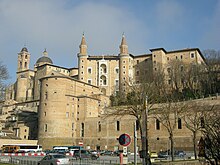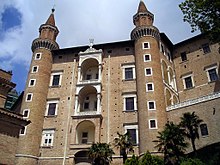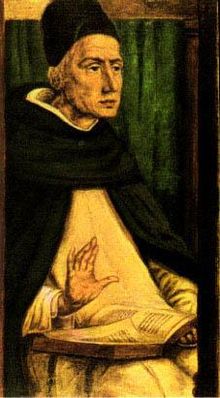Palazzo Ducale (Urbino)
The Palazzo Ducale is a renaissance ducal palace in the Italian city of Urbino in the Marche region, built mainly on behalf of Count Federico da Montefeltro between 1463 and 1472 . He now belongs to the world heritage of UNESCO .
Building history
The construction of the present-day palace follows on from an older palace of the Counts of Urbino in the area of the present-day north wing, the walls of which have continued to be used. This older palace is believed to have been from the late 14th century.
The renovation under Count Federico da Montefeltro began in 1454 with a wing on the east side, the so-called Palazetto della Jole. The wing comprised five rooms on the ground floor and a stately apartment of three rooms on the upper floor. The work continued until around 1460. At that time, the count's apartment was still at the west end of the old north wing.
It was not until 1463 that further tracts could be tackled. The rooms on the south and west sides of the large inner courtyard, which at that time did not yet have the famous arcade position, were built by 1465.
In 1466 the count succeeded in winning the architect Luciano Laurana as master builder. He originally came from Dalmatia and had probably previously worked in Mantua at the Este court and got to know Brunelleschi's ancient architecture in Florence. Laurana designed the column arcades of the rectangular inner courtyard and the west facade with the two round towers and the loggia in between. When Laurana left in 1472, the shell of the palace was largely completed; However, many details of the interior were still missing. In the course of the renovation, the new Graf Federicos apartment that can be experienced today was also created. Although it was in the same place as before, it had additional small rooms behind the tower facade, including the famous Studiolo .
After Laurana left, the work was presumably led by Francesco di Giorgio Martini from 1476 , who was primarily responsible for the interior fittings of the ducal living quarters. The portals and window frames were made by Ambrogio Barocci from Milan , who also decorated the interior. In the high, fully stuccoed rooms, the richly decorated doorways, chimneys and friezes by Barocci, Domenico Rosselli and their workshops stand out. After the death of Duke Federico (1482), the building remained partially unfinished. The second floor was added by Girolamo Genga in the first half of the following century, replacing a crenellated wreath.
The palace remained government building until the 20th century, housed municipal archives and authorities as well as the public collections of ancient inscriptions and sculptures: the Galleria Nazionale delle Marche (see below ). Restorations completed in 1985 have also made the extensive underground space accessible to the public.
The palazzo is also famous as the scene of the fictional conversations about court life that Baldassare Castiglione set in the Hall of the Night Watch in his work Il Cortegiano (1507).
Special premises
The Ducal Palace contains a number of rooms that reflect Federico's devotion to classical and humanistic studies and which were commonly used in his daily routine, such as visiting the Lararium and reading Greek literature. These learned and expressly pre-Christian aspects would have been untypical for a medieval palace.
The Studiolo
A main component of this concept is the Studiolo (a small study or prayer room), only 3.60 m × 3.35 m in size, with a view away from Urbino and beyond the rural goods. It was designed under Laurana around 1472 and its furnishings were completed around 1476. Its beautifully executed inlays, which surround the viewer with trompe-l'œil trims, benches and half-open lattice doors, behind which symbolic objects represent the liberal arts , represent the most famous example of Italy in this art. The benches carry musical instruments, and the shelves show representations of books and sheet music, scientific instruments (with an astrolabe and an armillary sphere ), study furniture (with a desk and hourglass), weapons and armor, and various other items (e.g. parrots in a cage and a mazzocchio ). The Studiolo also shows ideal portraits of various historical and contemporary people. Statues of Federico - in scholar clothing - and of Faith, Love and Hope are engraved on the inlay panels . Above it are a number of portraits of great authors (today partly as copies), painted by Joos van Wassenhove (with revisions by Pedro Berruguete ):
| North face | |||
|---|---|---|---|
| plato | Aristotle | Ptolemy | Boethius |
| St. Gregory | Jerome | Ambrose of Milan | Augustine |
| West wall | East wall | ||
| Pietro d'Abano | Petrarch | Moses | Cicero |
| Hippocrates | Dante | Solomon | Seneca |
| window | Thomas Aquinas | Homer | |
| window | Duns Scotus | Virgil | |
| South wall | |||
| Sixtus IV. | Albertus Magnus | Bessarion | Pius ii |
| Bartolus | Solon | Vittorino da Feltre | Euclid |
The top row (outside in the diagram) shows classical and humanistic authors, in contrast to the religious authors (to put it simply) in the bottom row (inside).
Twin chapels: Chapel of Forgiveness and Temple of the Muses
Down the stairs are the twin chapels, one Christian and one pagan. The entrance room emphasizes its connection with this inscription, an elegiac couplet :
|
Bina vides parvo discrimine iuncta sacella: altera pars musis, altera sacra deo est. |
You see the sacred spaces twice, connected by a small subdivision: one part is dedicated to the muses, the other to God. |
The Temple of the Muses, possibly the personal studio of Federico's son Guidobaldo , originally showed the Muses as “level-headed musicians”, perhaps a work by Giovanni Santi .
Galleria Nazionale delle Marche

The Galleria Nazionale delle Marche (National Gallery), which houses the palace, is one of the most important Renaissance art collections in the world. It is home to works by Raffael , Joos van Wassenhove (a Last Supper with portraits of the Montefeltro family and court), Melozzo da Forlì , Piero della Francesca (with the famous Flagellation of Christ ), Paolo Uccello , Timoteo della Vite , Titian (the Resurrection ) and another artist of the 15th century. In 2015, Peter Aufreiter became director of the Galleria Nazionale delle Marche.
Individual evidence
- ↑ Höfler 2004 is now decisive for the building history. This means that some older assumptions are obsolete or must now be discussed again.
- ↑ Höfler 2004, pp. 102–122.
- ↑ Höfler 2004, pp. 149–177.
- ^ Joscelyn Godwin , The Pagan Dream of the Renaissance (Grand Rapids: Phanes Press, 2002), pp. 90-91.
- ^ Godwin, pp. 91 and 94.
- ↑ Höfler 2004, pp. 162–163.
- ^ Godwin, p. 92.
- ↑ Godwin, pp. 92-94.
- ↑ See Cheles, p. 17.
- ^ Godwin, p. 91.
- ↑ Peter Aufreiter heads the Technical Museum. Retrieved June 24, 2019 .
literature
- Hartmut Biermann: The valley facade of the Palazzo ducale in Urbino. Attempt to interpret the content. In: Meeting reports of the Berlin Art History Society. New episode, 31 (1983). Pp. 10-11.
- Luciano Cheles: The Studiolo of Urbino: An Iconographic Investigation. Penn State Press, 1986.
- Joscelyn Godwin: The Pagan Dream of the Renaissance. Phanes Press, Grand Rapids 2002.
- Janez Höfler: The Palazzo Ducale in Urbino under the Montefeltro (1376–1508). New research on the history of construction and furnishings. Regensburg 2004.
- Robert Kirkbride: Architecture and memory. The Renaissance studioli of Federico de Montefeltro. New York 2008.
- Wolfgang Liebenwein: Studiolo. The emergence of a room type and its development up to around 1600. Berlin 1977, pp. 83–96.
- Werner Lutz: Luciano Laurana and the Ducal Palace in Urbino. Weimar 1997.
- Maria Luisa Polichetti (Ed.): Il Palazzo di Federico da Montefeltro. Restauri e ricerche. 2 vols., Urbino 1985.
Web links
- Website of the Galleria delle Marche
- World heritage list ; Unesco.org
Coordinates: 43 ° 43 ′ 24 ″ N , 12 ° 38 ′ 16 ″ E



